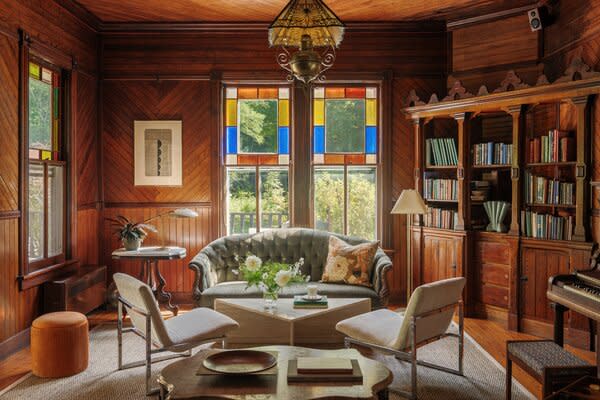"Bookshelf Wealth" Isn’t New. So Why Is It Taking Off?
Buying books for decor isn’t a novel concept, but the internet’s latest design buzzword has taken the popularity of BookTok and other trends and run with them.

If you’ve been on social media in the past month, it’s unlikely you’ve evaded "bookshelf wealth." The interior design buzzword entered the canon late last year and by mid-January was crowned "2024’s first major design trend." (To date, #bookshelfwealth has racked up 3.8 billion TikTok views.) The look, for those who could use an extra primer, is evocative of the warmth of a Nancy Meyers film: Romantic, but not too formal. Homey and character-filled. Messy and imperfect. Think: Nubbly sofas, vintage coffee tables, an antique vase filled with fresh-cut flowers. And, of course, bookshelves.
In an age where online trends arrive in the morning and are gone by afternoon, TikTok monikers for interior aesthetics have become something of the norm. But the craze around "bookshelf wealth" begs the question: Why is everyone suddenly feeling so literary?
It’s more than what you may expect. Over the past several years, home trends have ridden a hurtling pendulum. "During Covid, people were like, I have way too much stuff in my space, I got to declutter," says Susana Simonpietri, creative director at Chango & Co, a New York City residential design studio. Cue the monochromatic furnishings, all-white kitchens, and sparse wall art. It was the interiors edition of the barely-there makeup and slicked back buns we now call the "clean girl aesthetic." Bookshelf wealth emerged as a homespun maximalism rooted in individuality and personal history. Eventually, "the pandemic trended design away from minimalism and super-exacting styling and toward what is organic and personal," says Zoe Feldman, founder of the namesake Washington, D.C. design studio. "People want to be comfortable in their spaces, not so rigid. They also want designated spaces that serve as broader canvases for expression and design." (Let it not be forgotten that early 2020 quarantine gave us concepts like "bookcase credibility" and "celebrity bookshelf sleuthing," potentially planting some sort of literary decor seed, though buying books for decor isn’t new by any means.)
Ironically, the tenets of bookshelf wealth are a contradiction to the rapid trend cycle it’s been hitched to, encouraging a slow curation of items that carry unique personal relevance. "Bookshelf wealth describes an interior that feels like it has been handed down through time," says Lisa White, director of strategic forecasting and creative direction at WGSN, a trend analysis company. "It is an aesthetic that is part of a long-term lifestyle, one that has been built upon intentionally and continuously—it is not about being able to buy and curate a look in one go. It takes time, dedication and a profound feeling for every object and element of the space."
In fact, even the person whose bookshelf wealth TikTok primer has amassed over 1.3 million views since posting in late December asserts that despite its name, the trend is about more than vast displays of beautiful books. "The whole idea is really to surround yourself with things that fill your soul," says Kailee Blalock, cofounder of San Diego interior design firm House of Hive Design. "It’s not just about the books, but art and sculpture, and having a home that looks lived-in instead of museum-grade quality."
Even if bookshelf wealth is about more than what’s in your TBR stack, there’s still a connection to be drawn between the trending aesthetic and the rise of #BookTok, where TikTok users share reading recommendations. According to NPD Bookscan, a hallmark book sale analytics tool for the publishing industry, in 2021, BookTok-favored authors sold twice as many books compared to those not promoted on the social platform, at a substantially quicker rate, no less. BookTok has undoubtedly supercharged enthusiasm for reading among a large swath of the app’s users. But some BookTok diehards are wringing their hands over the trend’s potential notion that books might be bought simply for the aesthetics—not the writing contained within the pages. On Blalock’s viral TikTok, for example, one user wrote: "Don’t try to ‘achieve this vibe.’ Focus on cultivating a taste, exploring different literature and art, and your home will eventually look similar." Another comment reads: "Is this why books are getting so expensive because the Pinterest girls are buying them for decoration?"
Just as bookshelf wealth might not be as literary-leaning as its name suggests, the same is possible to argue for the latter half of the moniker. In fact, the aesthetic’s focus on heirlooms and collected vintage items fits into a wider movement fueled by Gen Z’s penchant for secondhand shopping. Take this trend report from resale app Depop: "In 2024, we’re balancing chaos and order by blending comfort and familiarity with individuality and unique style. Realism is back in vogue." Bookshelf wealth and other vintage-heavy aesthetics are set to only rise in popularity as Gen Z matures. Until then, see you at the bookshop.
Top photo by Emiliano Granado; original published in "How One Influencer Created a French-Chateau Vibe in Her Greenpoint Rental"
Related Reading:

